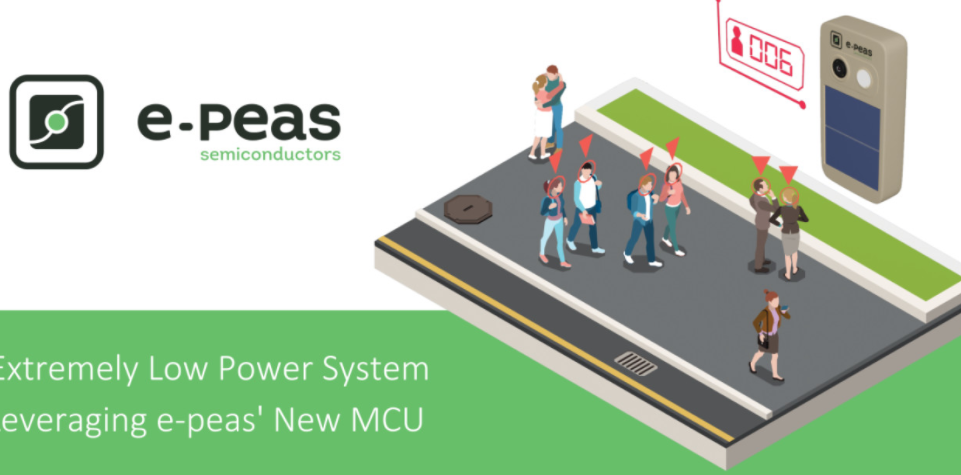
The energy autonomy monitoring system exhibited by e-peas supports energy mobile phones to meet their power needs and can be used for applications such as people counting and facial recognition (accessing stored data to confirm personal identity).
At the heart of the e-peas demonstration will be the game-changing EDMS105N MCU.
The EDMS105N MCU is a power-optimized 32-bit device that can run at 24MHz. It relies on the ARM Cortex-M0 processing core, leveraging platforms and related tools that engineers are already familiar with.
This is the lowest power Cortex-M0 MCU on the market, consuming only 18µA/MHz in active mode. It has a range of different sleep states, the lowest of which consumes only 340nA (RTC and 8kB SRAM retention).
Embedded in the MCU are a variety of different interfaces (UART, I2C and I2S, as well as a large number of GPIOs), as well as data conversion and voltage regulation components.
“The release of our EDMS105N MCU is the culmination of many years of intensive R&D work, and we are excited to see how broadly it will impact the IoT space in the coming years,” said Geoffroy Gossethe, co-founder and CEO of e-peas. “This is the first in a series of announcements that will make us a one-stop shop for all the critical IC components needed for extremely low-power systems.”
The RF energy harvesting antenna developed by e-peas in collaboration with Ignion of Spain is ten times smaller than standard off-the-shelf components and can be used in any frequency band and any device form factor with the appropriate matching network design to harvest energy at all frequencies in the range (0.4GHz to 10.6GHz range). When integrated with the AEM30940, AEM30330 or AEM30300 RF Environment Energy Manager (AEM), the antenna can capture energy from a distance of up to 17 meters when using a 1W transmitting source and achieve an energy capture range of 31 meters when using a 3W source. Since the antenna is independent of direction, it can capture energy from any direction.
Previous article:Renesas uses dynamic charge pump to break through MRAM write bottleneck
Next article:Low-power MCU scoring benchmark from EEMBC
Recommended ReadingLatest update time:2024-11-16 19:39






- Popular Resources
- Popular amplifiers
-
 Wireless Sensor Network Technology and Applications (Edited by Mou Si, Yin Hong, and Su Xing)
Wireless Sensor Network Technology and Applications (Edited by Mou Si, Yin Hong, and Su Xing) -
 Modern Electronic Technology Training Course (Edited by Yao Youfeng)
Modern Electronic Technology Training Course (Edited by Yao Youfeng) -
 Modern arc welding power supply and its control
Modern arc welding power supply and its control -
 Small AC Servo Motor Control Circuit Design (by Masaru Ishijima; translated by Xue Liang and Zhu Jianjun, by Masaru Ishijima, Xue Liang, and Zhu Jianjun)
Small AC Servo Motor Control Circuit Design (by Masaru Ishijima; translated by Xue Liang and Zhu Jianjun, by Masaru Ishijima, Xue Liang, and Zhu Jianjun)
 Professor at Beihang University, dedicated to promoting microcontrollers and embedded systems for over 20 years.
Professor at Beihang University, dedicated to promoting microcontrollers and embedded systems for over 20 years.
- Innolux's intelligent steer-by-wire solution makes cars smarter and safer
- 8051 MCU - Parity Check
- How to efficiently balance the sensitivity of tactile sensing interfaces
- What should I do if the servo motor shakes? What causes the servo motor to shake quickly?
- 【Brushless Motor】Analysis of three-phase BLDC motor and sharing of two popular development boards
- Midea Industrial Technology's subsidiaries Clou Electronics and Hekang New Energy jointly appeared at the Munich Battery Energy Storage Exhibition and Solar Energy Exhibition
- Guoxin Sichen | Application of ferroelectric memory PB85RS2MC in power battery management, with a capacity of 2M
- Analysis of common faults of frequency converter
- In a head-on competition with Qualcomm, what kind of cockpit products has Intel come up with?
- Dalian Rongke's all-vanadium liquid flow battery energy storage equipment industrialization project has entered the sprint stage before production
- Allegro MicroSystems Introduces Advanced Magnetic and Inductive Position Sensing Solutions at Electronica 2024
- Car key in the left hand, liveness detection radar in the right hand, UWB is imperative for cars!
- After a decade of rapid development, domestic CIS has entered the market
- Aegis Dagger Battery + Thor EM-i Super Hybrid, Geely New Energy has thrown out two "king bombs"
- A brief discussion on functional safety - fault, error, and failure
- In the smart car 2.0 cycle, these core industry chains are facing major opportunities!
- The United States and Japan are developing new batteries. CATL faces challenges? How should China's new energy battery industry respond?
- Murata launches high-precision 6-axis inertial sensor for automobiles
- Ford patents pre-charge alarm to help save costs and respond to emergencies
- New real-time microcontroller system from Texas Instruments enables smarter processing in automotive and industrial applications
- Wireless Earbud Battery Ultra-Low Standby Power Consumption Reference Design
- When MOS tubes are connected in parallel, do they have to be symmetrical?
- TA0CCR0 interrupt of msp430
- What are the 9 most important applications of the Internet of Things (IoT)?
- MOS tube burnt out
- About CS1256 Analog Chip
- At the same frequency, the impedance of a large capacitor is smaller than that of a small capacitor, and it has better filtering performance for high frequencies. Why do we need to connect a small capacitor in parallel?
- [GD32E503 Review] Part 5: FreeRTOS Project Creation
- I heard that ST has released a LoRa development board, NUCLEO-WL55JC2. Why can't I find any information about it anywhere in the world?
- MT7603EN Supply

 Wireless Sensor Network Technology and Applications (Edited by Mou Si, Yin Hong, and Su Xing)
Wireless Sensor Network Technology and Applications (Edited by Mou Si, Yin Hong, and Su Xing)
















 京公网安备 11010802033920号
京公网安备 11010802033920号